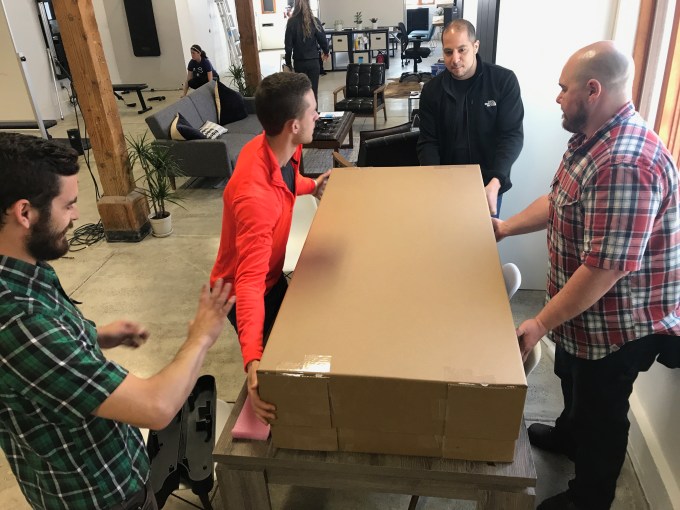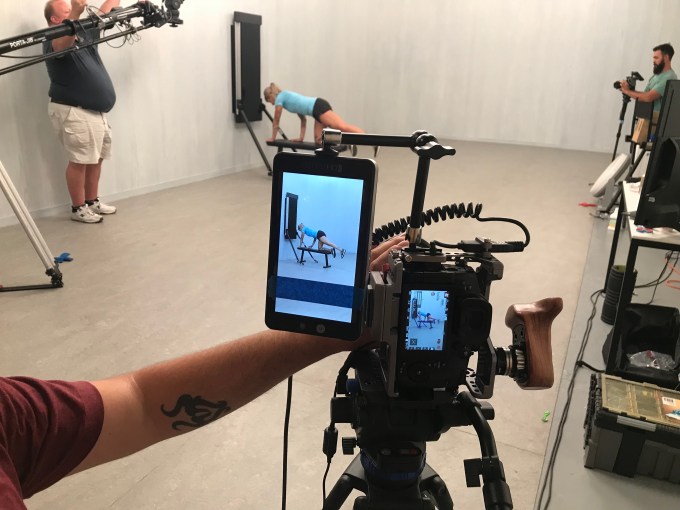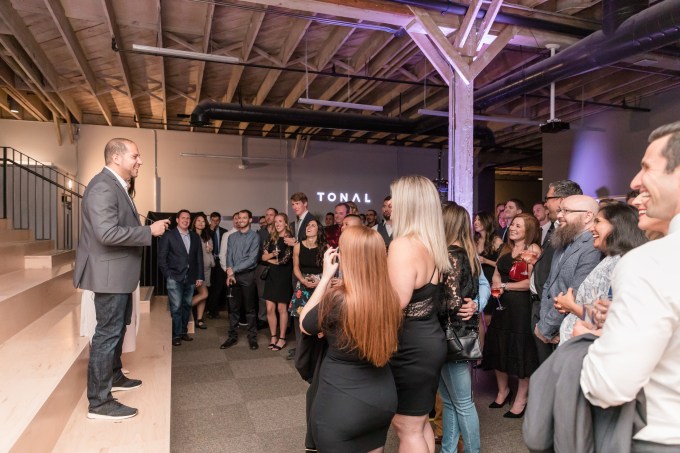Launching a product is a nonevent for many startups. In software, it’s not uncommon to put together a flimsy working prototype over a couple of hours and publish it immediately to start generating feedback from early users and get that iterative flywheel spinning.
Launching has a very different meaning, though, for hardware. Once that physical product leaves the warehouse, the design team can’t patch the hardware itself. It’s got to work reliably, be easy to use and most importantly, be safe for users straight out of the box. Even more important than readying the product itself is the sales and marketing engine that accompanies a launch. For hardware startups, a mislaunch may well lead straight to bankruptcy as hardware inventory piles up and cash flow becomes constrained. You just can’t get a launch wrong.
In part one of this EC-1, we looked at the three-and-a-half years of Tonal’s origins and how a scrappy entrepreneur in the form of founder and CEO Aly Orady continued to iterate upon prototypes of an all-in-one strength-training device powered by electromagnetics — a technology he had never worked on before. We also saw how he eventually won over several investors including Bolt, Mayfield, Shasta and Sapphire Ventures, who saw the potential in his device once they experienced it for themselves.
Tonal’s individual components were all ready, but how should it bring them together and create a successful launch?
Company building, brand building, launch strategy and marketing tactics are key to the success of most startups — and that’s what this second part of the Tonal EC-1 is all about. We will look at how Tonal’s designers changed the product based on feedback during its beta period. We’ll look at how Tonal’s product focus on strength training forced it to adapt a typical hardware launch strategy to optimize for the consumers it was hoping to target. Finally, we will explore the company’s marketing and launch strategy — and one key and seemingly smart decision at the time that proved to be an early blunder and humbling lesson in hindsight.
Iterating when a build isn’t one click
Unlike, say, productivity software where a user might be logged in for much of a work day spewing out usage data, Tonal is a strength training device, which means that users only use it for a limited period of time a couple of days per week. That made receiving sufficient authentic feedback on early units challenging.
Getting to a point where the prototype was usable and somewhat reflected the final product in its feature set was therefore a lengthy process. Following the small alpha trial in 2016 that RiptLabs (later renamed Tonal) performed in a San Francisco apartment, the startup began an extensive year-long beta trial in early 2017 that placed prototype devices into 25 homes with at least two people in each home, and the company tracked those users for a year.
“Our first community manager [Sarah Johnson] would actually call those users on a regular basis and chat with them about their workouts,” recalls Orady. The goal was to elicit as much feedback as possible in order to help the product team iterate their designs.
RiptLabs made a number of design decisions and changes based on feedback during the beta. They swapped out the horizontal displays in the alpha trial units for vertical ones, which better matched how people stood in front of the machine. A less obvious change was actually decreasing the size of the screen on the Tonal unit to 24 inches. Although the team prototyped 24-, 27- and 30-inch displays — off-the-shelf screens simply attached to the devices with duct tape — the team learned that larger screens made users subconsciously step further away from the device than intended, which complicated their completion of Tonal’s routines.

Unlike stationary bikes, Tonal’s exercises require users to adjust the device regularly to match the requirements of the next exercise, much like traditional gym equipment. Orady considered the idea of employing self-adjusting left and right arms — which needed to be manually moved up, down and rotated in different positions by pressing buttons and levers — so the arms automatically repositioned themselves for different exercises. That approach may well have offered a more delightful workout experience for users if implemented, but doing so, however, would mean including more complex, moving parts in the device that would ultimately drive up Tonal’s price point. In the end, he settled for repositioning the buttons and levers that adjusted the arms into different positions based on how beta users interacted with their devices.
At the same time, Tonal Chief Content Officer Ryan Vance ramped up on content development in preparation for the device’s looming launch. One aspect he and Orady were firm about was avoiding the linear nature of many at-home fitness classes. Other device makers, including Peloton, Echelon, NordicTrack, Tempo and Mirror, produce and edit their classes in much the way traditional TV series are shot; they film people using different cameras and stitch together the best shots, even for live classes. But those classes are ultimately linear — the classes don’t change based on how the user is doing during the workout.
That linear structure doesn’t apply as easily to Tonal’s strength-training emphasis, since different users may perform more or less reps or take more or less time to complete an individual set. To handle this variability, Vance and other RiptLabs employees developed what they dubbed a “responsive content system” with a “TimeFlex” feature, which paces the speed of the class based on how quickly (or slowly) users perform their weight sets.
If a user moves more slowly through a class during a particular weight set than planned, the prototype essentially “waited” for the user to catch up, weaving in additional shots and several more voiceover lines from the instructor until the user finished and was ready for the next portion of the class. It’s a particularly useful feature and also a unique approach that other at-home fitness makers have yet to replicate in their own content.
“You can be on the bike during a Peloton ride, and you can get off the bike and go make a sandwich — the Peloton class keeps on going,” says Vance. “The bike doesn’t really know what you’re doing. If you get off the Tonal and make a sandwich, the Tonal is going to wait for you.”
Unlike cardio exercise equipment, strength training has many more variables for users that can all be adjusted on the fly, such as the type of exercises, the number of reps and the resistance of the device. Orady’s product vision was to develop an AI capability inside Tonal sufficient to adapt classes in real time to how users performed during individual weight sets.
The team developed features that incrementally and cumulatively add resistance to users’ weight reps the more they work out and the more classes they take. Tonal also included a “Burnout” mode if the sensors inside the device detect that users are struggling to complete repetitions and sets — a feature that tends to come in particularly handy for novice and intermediate strength trainers.
A marketing strategy of education over glitz
Once Orady and the Tonal team arrived at a near-final prototype in early 2018, Orady decided the startup would launch later that year. He landed upon August as the ideal month to launch ahead of the holiday season, allowing the company to onboard a first wave of real users before the intense end-of-year shopping period.
A huge strategic question facing the company was how to market a device — priced at a very premium $2,995 for just the base equipment — in a way that allowed consumers to understand what made Tonal unique. Unlike treadmills or stationary bikes where the vast majority of products are variations on a theme, Tonal’s design was entirely novel. While it was based on existing gym equipment stations, users had never before quite seen the combination of electromagnets, digital content and adaptive software like Tonal had packaged together.
Then-CMO Nate Bosshard enlisted several outside marketing agencies and partners to help develop the first set of marketing materials — a series of still ads and online videos — with the objective of quickly inculcating shoppers on what the device was and how its AI-driven digital weights system differentiated it from other strength-training entrants on the market. This was unlike other premium exercise equipment providers like Peloton and gym networks like Equinox, which tended to focus on exercise as a premium lifestyle choice.
The marketing launch materials were part of an “educational” marketing phase as Tonal called it, and the company focused on three main talking points around what the device could do. Its first video ad, voiced by actor Ed Norton, for instance, plugged Tonal as the “world’s most intelligent fitness” system, noting its all-in-one at-home convenience, hundreds of hours of weight-training classes and advanced AI for tracking weight reps and progress.
“A lot of those assets weren’t super polished, but they were very educational,” notes Tonal’s current CMO Christopher Stadler. “I would call them low on ‘sizzle’ and high on information. They had simple, very straightforward imagery, and it was kind of clean and basic, but they weren’t particularly upscale, and they didn’t have lots of ‘personality.’”
Tonal’s early classes could also be considered clean and basic. Content was initially filmed with the startup’s six or so instructors against a simple gray-toned wood background in its San Francisco office and studio, which by then included an old gym nearby that it had rented and expanded into.
“It was just a gray wall — it wasn’t as glamorous as it is now — and our wardrobe was terrible,” admits Liz Letchford, one of Tonal’s first fitness instructors.

That emphasis on education in its marketing strategy also persuaded the company to invest in a retail footprint from the very beginning of its launch. In April 2018, Tonal opened its first showroom in San Francisco’s Cow Hollow neighborhood, which was part of a larger, longer-term retail plan to eventually open physical stores across the country where shoppers could try its devices for themselves. At the time, however, access to the showroom was appointment-only and limited to invited friends, family and shoppers. The showroom’s windows were frosted for privacy purposes, and all showroom visitors were required to sign NDAs.
“One of the key things that we learned then from that showroom is that you don’t actually need to do a full workout to want to buy a Tonal — a 10-minute demo was enough,” recalls Orady.
How Tonal approached its longer-term retail expansion was heavily informed by that debut showroom during its first year. The company realized that opening locations in family-friendly, heavily trafficked areas was key for raising brand awareness and converting customer tryouts into purchases. (Tonal declined to disclose the sales conversion rates of its current 16 showrooms across the U.S.)
A staggered launch that also staggered Tonal
The company’s emphasis on education rather than hype influenced several other decisions. Tonal’s chief executive decided not to offer pre-sales, or sell the device before it actually began shipping, tactics that have been commonly used across hardware products and, for instance, every Kickstarter project. This was partly done to avoid having to advertise a completed set of features ahead of launch — features that Orady was concerned might not make it into the device on day one.

Yet, the biggest decision made by the team for launch also proved to be something of a mistake in retrospect. Rather than launch nationwide — or even across several cities across the United States — as many other at-home fitness makers had done, Orady opted for a slower staggered approach, making the device initially available only in the San Francisco Bay Area in August 2018 before expanding to California by that December. In fact, it wasn’t until March 2019 that Tonal became available nationwide.
There were several reasons a local launch would make sense. Advertising dollars could be concentrated on one market, rather than spread thinly nationwide. That would help generate better word-of-mouth, while also keeping Tonal’s initial launch costs lower. Second, a local launch would match the company’s retail-focused strategy, ensuring that customers who had heard about the product could easily head to a store to try it. Third, given that the Tonal team was also predominantly located in SF, they could handle distribution and product issues more effectively given that they would be nearer to their initial customer base. All those reasons and more convinced the company that a staggered and local launch approach would work best.
Orady says that if he has regrets about the launch though, it’s that the staggered approach created confusion among some shoppers across the U.S. who failed to understand why they couldn’t get a device right then and there. Even more damaging for Tonal, the customer confusion persisted long after its product’s nationwide availability in March 2019 and also contributed to Tonal’s slow growth rate in the immediate months after launch.
“Erasing from people’s memories that we were not available nationwide turned out to be really, really hard,” explains Orady. “We became nationwide on March 1 [2019], but I would still get emails from people six months later asking things like, ‘Are you guys available yet in Alabama?’ I’d have to say, ‘Yes, we’re nationwide now.’”
If Orady could do it all over again, he also would have leaned heavily on TV advertising. In the months and years since launch, TV ads have proven to be an effective marketing channel for the startup in increasing brand visibility, but Tonal avoided TV spots entirely during the first six months after the device’s launch.
“Advertising on TV locally is just not very efficient, so we really avoided TV ads for the first six months,” adds Orady. “In retrospect, if we had coupled nationwide TV ads with a nationwide launch starting in August [2018], it would have really been very, very different for our business in terms of early growth rate.”
While Tonal’s slow launch may have initially hampered growth, the startup would later see demand skyrocket a year-and-a-half later once the COVID-19 pandemic struck, forcing people to stay at home. According to Tonal’s CMO Stadler, the startup saw sales surge 800% from December 2019 to December 2020, causing wait times of up to 10 to 12 weeks for deliveries to arrive. In response, the startup significantly ramped up production of devices, increased employee headcount, and in some cases, now air-ships equipment directly from Taiwan to the United States to meet demand, according to Stadler.
Warm reviews, but can Tonal build a warm community?
When Tonal initially launched in August 2018, the device was (and remains) priced at $2,995 for the base unit, plus $495 for “Smart Accessories” that include handles, a bench press bar, a rope, a bench, a roller and a workout mat. (Like Peloton, access to any and all classes requires a membership subscription, which Tonal priced at $49 per month.) Given the handles, bench press bar, and bench are essential to most Tonal classes, that meant the effective price point to purchase a Tonal reached nearly $3,500 — a high price point that some product reviews have noted.
“It’s a bold — and at $2,995, pricey — venture into the home workout market,” wrote Men’s Journal in September 2018, adding that the device’s convenience and space-saving aspects made the product worth consideration.
In December 2018, PCMag wrote a similarly positive hands-on article, noting the device’s effectiveness and future potential.
“The Tonal System isn’t cheap, but neither is a gym membership … As the cold weather kicks in, and the dark mornings seem drab, it must be easier than heading out to the gym,” S.C. Stuart wrote. “Slip into sweats, walk up to your Tonal and select an encouraging coach to prep you for the day. Especially as you know there’s an AI peering back at you, helping you reengineer your corporeal form for the future.” It was also designated an “Editor’s Choice” and awarded 4.5 out of five stars.
It was a successful launch, despite some flaws. An extensive alpha and beta test allowed the product team ample time to solicit feedback to iterate on the product, and an educational marketing campaign helped bridge the gap between curious consumers and Tonal’s unique product offering in strength training.
Yet, the next challenge for the company starts just minutes after the box is opened, since once Tonal owners receive their devices, keeping them thoroughly engaged becomes paramount for the subscription business the startup is ultimately building. The third part of Tonal’s EC-1 will explore how the startup attempts to stay connected with current Tonal owners — and users waiting for their orders — through its online community, including a moderated Facebook Group.
Tonal EC-1 Table of Contents
- Part 1: Origins
- Part 2: Product launch
- Part 3: Community building
- Part 4: Competitive landscape and future
Also check out other EC-1s on Extra Crunch.
Updated March 30, 2021: Changed the name of Tonal’s original name from Ripped Labs to RiptLabs.































Comment